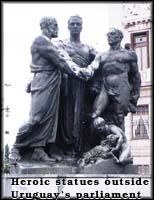
To market, to market for action!
"Montevideo," said the guide book, "is pretty sedate
by most standards." The first impression, on leaving the harbour gates,
is even more depressing. A bastion of solid, administrative-style buildings
confronts the stranger and there is no sign of where the action might be.
The successful traveller often has to rely on instinct and a nose for
the offbeat to find what the guide books overlook. Thus it was by nose,
rather than guidance, that I ducked down a lane leading between two overweight
buildings opposite the port, and found Mercado Del Puerto, the port  market. market.
Here I discovered medio y medio, or half and half.
Montevideo is the capital and chief port of Uruguay, a country on the
Atlantic coast of South America, bounded in the north by Brazil and to
the west by Argentina. It declared independence in 1825, a status accepted
by its neighbours some 28 years later. The capital is home to nearly half
of Uruguay's population of 3.2 million.
It is a superb port on the east bank of the Rio de la Plata (the River
Plate) and the outlet for Uruguay's exports of grain, meat products and
hides. Its industries include meat packing, tanning, footwear, flour milling
and textiles.
The port, a rival to Buenos Aires on the opposite bank, made Montevideo
the focal point for shipping. The city was founded in 1726 by Spain in
response to Portugal's growing influence over the River Plate area. Many
of its early residents came from the Canary Islands.
The city is top heavy with what the same guide book calls "undistinguished,
utilitarian bureaucratic public buildings that would not be out of place
in Eastern Europe." The imposing Palacio Legislativo contradicts that.
It is a neo-classical pile flanked by Herculean statues of lusty men in
heroic camaraderie.
The interior of this Legislative Palace, where the General Assembly
meets, is a wonder of marble. Floors, columns, walls and heraldic arches
are all of marble. There are marble pots balanced on friezed marble columns.
The wax-work guards at the entrance to the Senators Chamber are actually
not made of wax but of flesh, being human despite their immovability. These
men in medieval uniform have to remain motionless, and not even blink when
visitors flash their cameras in awe.
The palace abounds in stained glass windows, reception rooms opening
on to balconies overlooking the north end of the Avenue of the Liberator
General Lavalleja, and huge panels of oil paintings depicting epic historical
moments in Uruguay's history. Entrance to the palace is free and it is
a popular call on conducted tours of the city.
After the culture, comes the cuisine, which is what I found by chance
at the Port Market. It opened in 1868 and retains its impressive structure
of wrought-iron roof complete with ornate iron pillars garnished with rococo
tidbits, and tall, wrought iron gates.
The square it adjoins has been transformed into trendiness with restaurants
under the arches of its cloisters. Here the smart set linger while strolling
musicians entertain. Across from the restaurants, outside the market, are
freelance vendors displaying local handicrafts, and some stalls of antique
knickknacks. Here, old cameras vie with cutlery and teapots to attract
the impulsive curio collector.
Inside, the market is no longer dedicated to rural produce, but to the
inner man: it consists of stand-up bars and snack counters where you can
have what you like, as long as it is beef. Uruguayans thrive on beef and
the standard meal is the parrillada, a platter of beef.In front
of gigantic charcoal grills which display the different cuts available,
cooks work in the open for all to see their dexterity.
I watched one man create matambre relleno, a yard of rolled and
stuffed flank steak. He worked fast, scooping up red peppers, bacon and
other slices of meat and laying them on top of each other on the flank
steak base.
Then he rolled the layers together, bound them up with string to keep
all the meaty bits intact, and put the roll on the grill, where it joined
great wheels of sausages and sizzling steaks. Matambre is eaten
cold or hot, sliced thinly for sandwiches, or in chunks as an appetiser.
For me, it tasted delicious, despite my having seen how crudely it was
prepared.
Montevideo's market is a fine place for people watching, even if what
people are doing is not always polite. Darker nooks and crannies are favoured
for trysts of a professional nature. Despite its staid image, the exuberance
of life in South America cannot be stifled, even in bureaucratic Montevideo.
Perhaps as a contrast to the dull city streets, the market has a sense
of humour. One bar has its stools painted with clock faces so you can sit
on time and forget about it. At the Cafe Roldos, souvenir drinks trays
are on sale, commemorating the cafe's existence in the same place in the
market for 113 years. Its banner awning proclaims it is the home of Medio
y Medio.
I've saved this, the best, for the end. "Half and half" turns
out to be a glass filled half with white wine and half with sparkling wine.
It has become such a popular drink in Uruguay, it is prepared and sold
in bottles so it can be bought ready mixed.
To a wine connoisseur its taste might be disgusting - it is sweetly
potent - but it was a fitting reward for finding Montevideo's offbeat market
a few yards beyond the port's gates.
|





 market.
market.